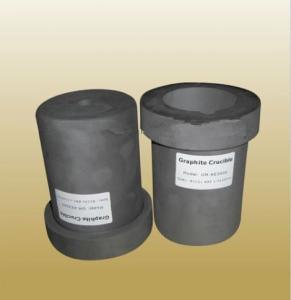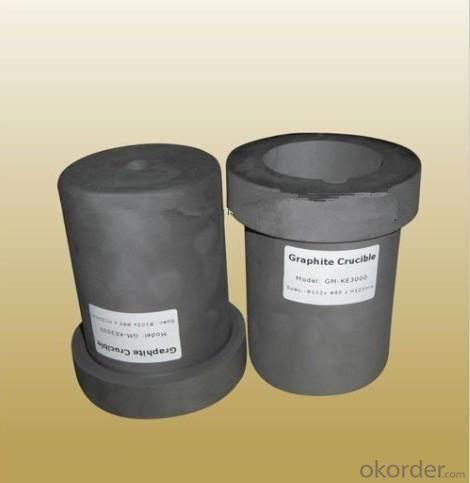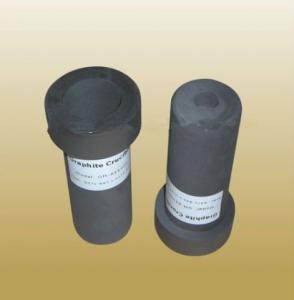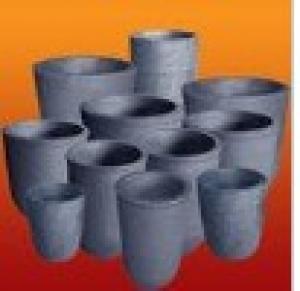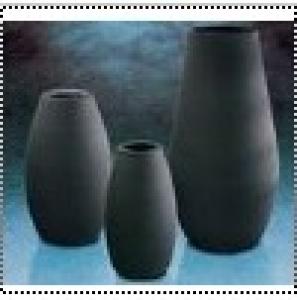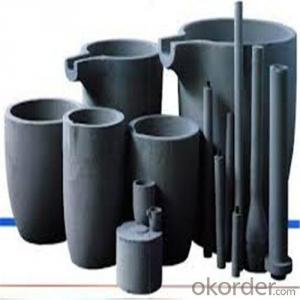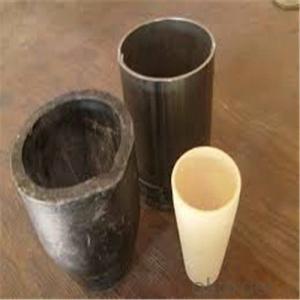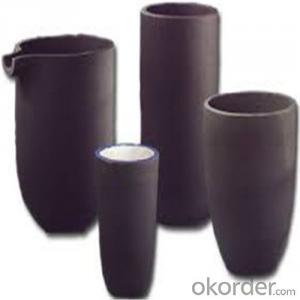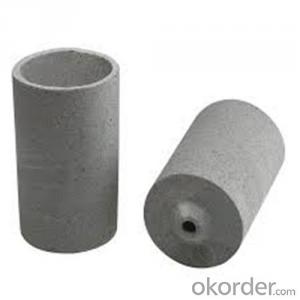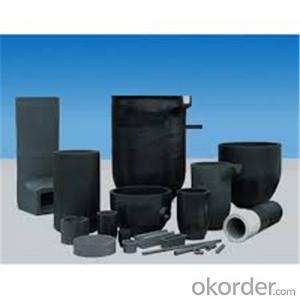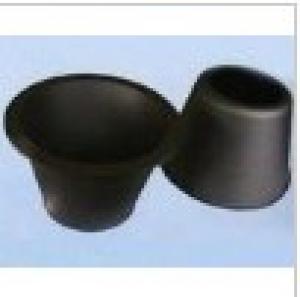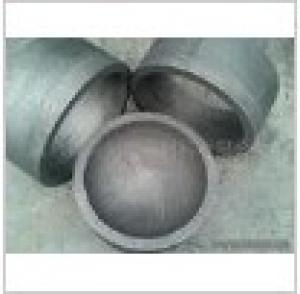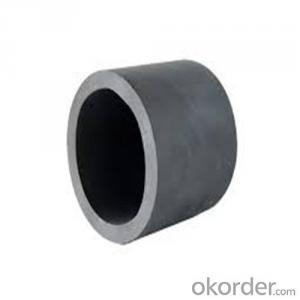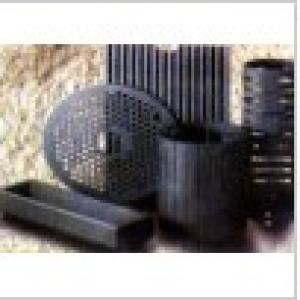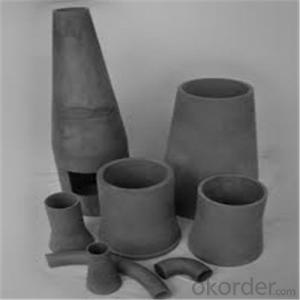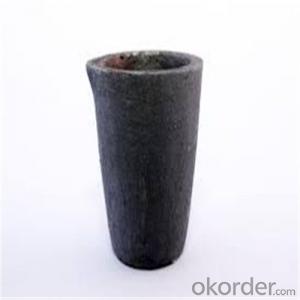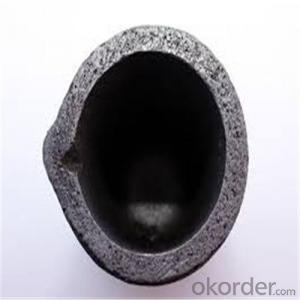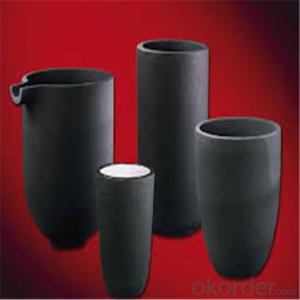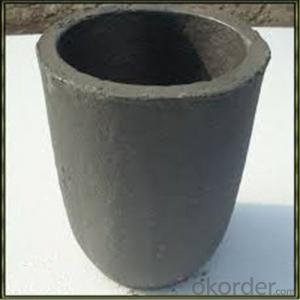100 oz Kerr Graphite Crucible - Tempering A Graphite Crucible
- Loading Port:
- China Main Port
- Payment Terms:
- TT or LC
- Min Order Qty:
- 50 Pieces pc
- Supply Capability:
- 10000 Pieces per Month pc/month
OKorder Service Pledge
Quality Product, Order Online Tracking, Timely Delivery
OKorder Financial Service
Credit Rating, Credit Services, Credit Purchasing
You Might Also Like
Detailed Product Description
Graphite melting crucible
Metal type : gold , silver and brass & copper
3 Kilos melting capacity
Kerr electro melt oven
Graphite Crucible 3 Kilos, Fits Kerr Electric Auto Furnace
Item Description
-
Graphite Crucible 3 Kilos, Fits Electric Auto Furnace.
-
This is a new Graphite Crucible designed for the Hand held Melting Furnace.
-
Can be used for all metal types, like gold ,silver,copper etc.
-
This model has the groove in the top for the wire type crucible tongs.
-
Measurements :
-
Top outside diameter (mm) : 102mm
-
Top inside diameter (mm) : 85 mm
-
Height with the top (mm) : 125mm
- Q: How do you prevent graphite crucibles from sticking to the melted material?
- To prevent graphite crucibles from sticking to the melted material, there are several steps that can be taken: 1. Apply a release agent: Before placing the material in the crucible, a thin layer of a release agent can be applied to the inside surface of the crucible. This can be done using a brush or spray. The release agent acts as a barrier between the crucible and the melted material, preventing them from sticking together. 2. Preheat the crucible: Prior to adding the material, preheating the graphite crucible can help reduce the chances of sticking. Heating the crucible to a temperature slightly higher than the melting point of the material can create a thermal barrier that prevents the material from adhering to the crucible. 3. Use flux: In some cases, the addition of a flux can help prevent sticking. Flux is a chemical compound that lowers the melting point of the material and facilitates its flow. It can also act as a protective barrier between the crucible and the melted material, preventing them from sticking together. 4. Control the temperature: It is important to maintain the proper temperature throughout the melting process. If the temperature is too high, it can cause the material to become more reactive with the crucible, leading to sticking. Conversely, if the temperature is too low, the material may not fully melt, increasing the chances of sticking. Following the recommended temperature range for the material being melted can help prevent sticking. 5. Properly clean and maintain the crucible: Regularly cleaning the crucible after each use is essential to prevent buildup or contamination that can lead to sticking. It is important to remove any residual material or debris from the crucible using appropriate cleaning methods. Additionally, inspecting the crucible for any signs of wear or damage and replacing it when necessary can help prevent sticking. By following these preventive measures, the risk of graphite crucibles sticking to the melted material can be significantly minimized, ensuring a smooth and efficient melting process.
- Q: Can graphite crucibles be used for carbon nanotube synthesis?
- Yes, graphite crucibles can be used for carbon nanotube synthesis. Graphite is a suitable material for this purpose due to its high melting point and chemical stability at high temperatures. When carbon nanotubes are synthesized, a carbon source is typically heated to a high temperature, and graphite crucibles can withstand these extreme conditions without reacting or contaminating the nanotubes. Additionally, graphite crucibles have good thermal conductivity, which helps to maintain a uniform temperature during the synthesis process. Therefore, graphite crucibles are commonly used in laboratories and industries for the production of carbon nanotubes.
- Q: How do you prevent graphite crucibles from cross-contamination during use?
- To prevent graphite crucibles from cross-contamination during use, it is important to follow a few key steps. Firstly, it is crucial to properly clean the crucible before each use. This can be done by thoroughly washing it with a suitable cleaning agent and rinsing it with distilled water. It is important to ensure that all residual materials from previous use are completely removed. Secondly, it is advisable to dedicate specific crucibles for different types of materials or applications. This prevents the risk of cross-contamination between different substances. For example, one crucible can be used exclusively for metals, while another can be used for non-metals. Additionally, it is important to handle the crucibles with clean, gloved hands to avoid introducing any contaminants. Moreover, it is recommended to store the crucibles in a clean, dry environment to minimize the risk of contamination. During use, it is crucial to avoid overheating the crucible excessively, as this can lead to degradation or contamination of the graphite material. It is best to follow the manufacturer's guidelines for temperature limits and heating/cooling cycles. Lastly, it is good practice to regularly inspect the crucibles for any signs of wear or damage. If any cracks, chips, or other forms of damage are observed, it is important to replace the crucible to prevent any potential contamination. By following these preventive measures, one can minimize the risk of cross-contamination during the use of graphite crucibles, ensuring accurate and reliable results in various applications.
- Q: Are there different sizes available for graphite crucibles?
- Indeed, graphite crucibles are offered in various sizes to cater to diverse needs and applications. These crucibles come in a plethora of sizes, ranging from petite ones suitable for jewelry making or minor laboratory experiments to more substantial ones used for industrial purposes such as metal casting or melting. The necessary size of the crucible is contingent upon the quantity of material to be melted or processed, as well as the unique demands of the application at hand. Consequently, an array of sizes is made available to satisfy distinct requirements and guarantee the optimal and proficient utilization of graphite crucibles.
- Q: Rotary kiln dust removal, zinc coated sand and Zinc Oxide Technology
- The use of Nianzi extracted from zinc in zinc,
- Q: How does a graphite crucible handle chemical resistance?
- A graphite crucible is highly resistant to chemical corrosion due to the inherent properties of graphite. Graphite is composed of carbon atoms arranged in a hexagonal lattice structure, which provides it with exceptional chemical stability. It is non-reactive with most chemicals, including acids, bases, and organic solvents. The chemical resistance of a graphite crucible is primarily attributed to its high melting point and low reactivity. Graphite has a melting point of over 3,500 degrees Celsius, which allows it to withstand extreme temperatures and resist chemical degradation. This makes it suitable for a wide range of applications involving high-temperature processes, such as melting metals and alloys. Furthermore, graphite has a non-porous structure, which prevents chemicals from permeating its surface. This non-porosity minimizes the risk of chemical absorption, ensuring that the crucible remains chemically inert and resistant to corrosion. As a result, it can be used with various reactive substances without the fear of contamination or chemical reactions. However, it is important to note that while graphite crucibles are highly resistant to most chemicals, they may still be susceptible to certain aggressive substances under specific conditions. For instance, graphite can react with strong oxidizing agents such as fluorine gas or molten alkali metals. Additionally, prolonged exposure to certain corrosive environments or extreme temperatures can gradually degrade the crucible's resistance. In summary, a graphite crucible exhibits excellent chemical resistance due to its high melting point, non-reactive nature, and non-porous structure. It can effectively withstand the corrosive effects of most chemicals encountered in various industrial processes, making it a reliable choice for applications requiring chemical stability. However, it is crucial to consider the specific chemical environment and conditions to ensure optimal performance and longevity of the crucible.
- Q: Who can give a detailed description of the degree of volatility of graphite at various temperatures?
- Graphite is a nonmetallic mineral with high temperature resistance and conductivity. Graphite products made of graphite are widely used in metallurgy, smelting and vacuum furnaces
- Q: What are the welding methods at the end of the thermocouple?
- Argon arc welding type K thermocouple argon arc welding equipment consists of 5 parts, such as DC welding power supply, high frequency oscillator, welding gun, welding power supply and clamp. When welding, the cerium tungsten wire extending out of the welding nozzle is used as the negative electrode, and the welding thermocouple is fixed on the fixture as an anode. When the poles by high frequency and high voltage when the arc ignition function, using thyristor voltage control, arc intensity, under the protection of argon to cerium tungsten and generating arc discharge between welding thermocouple, high temperature generated by the arc melting end of the thermocouple wire into a ball. In order to facilitate the alignment of the thermocouple with the electrode, the work fixture and the welding torch can move in both horizontal and vertical directions. The welding torch is equipped with cerium tungsten electrode of diameter 1mm and 1.5mm, which is used for welding thermocouples of different diameters.
- Q: Can graphite crucibles be used for laboratory analysis?
- Yes, graphite crucibles can be used for laboratory analysis. They are commonly used in high-temperature applications such as melting and analyzing various materials, including metals, alloys, and minerals. Graphite crucibles offer excellent thermal stability, high resistance to chemical corrosion, and good heat transfer properties, making them suitable for laboratory analysis purposes.
- Q: How do you prevent graphite crucibles from cracking or breaking?
- To prevent graphite crucibles from cracking or breaking, there are several key factors to consider: 1. Proper handling: Graphite crucibles should be handled with care, avoiding any impact or rough handling that could cause stress and potential damage. Always use appropriate lifting tools and avoid dropping or hitting the crucibles against hard surfaces. 2. Controlled heating and cooling: Graphite crucibles should be heated and cooled gradually to prevent thermal shock. Sudden temperature changes can cause stress and cracks in the crucible. It is recommended to use a programmable furnace or kiln that allows for controlled and gradual temperature changes. 3. Preheating: Before using a new graphite crucible or when reusing a previously used one, it is important to preheat it slowly to remove any moisture or impurities that could cause thermal expansion and lead to cracking. This can be done by gradually increasing the temperature in the furnace. 4. Avoid overloading: Graphite crucibles have a maximum capacity that should not be exceeded. Overloading the crucible can cause excessive stress during heating and may lead to cracks or breakage. Always follow the manufacturer's recommendations regarding the maximum capacity of the crucible. 5. Avoid rapid cooling: After using a graphite crucible, it is important to allow it to cool down gradually. Avoid exposing the hot crucible to cold air or water, as rapid cooling can cause thermal shock and result in cracking. Instead, let it cool naturally in the furnace or kiln before removing it. 6. Regular maintenance: Inspect graphite crucibles regularly for any signs of wear, such as cracks, chips, or erosion. Replace any damaged crucibles immediately to avoid further damage during use. Additionally, proper cleaning and storage of crucibles when not in use can help prolong their lifespan. By following these guidelines, you can greatly reduce the risk of cracking or breaking graphite crucibles, ensuring their longevity and optimal performance in various applications.
We are always keeping enlarging production scale, perfecting management system, and improving office facilities to expand our markets both at home and abroad.We sincerely welcome clients at home and abroad to come for negotiations.
1. Manufacturer Overview
| Location | Guangdong,China (Mainland) |
| Year Established | 2010 |
| Annual Output Value | |
| Main Markets | North America South America Eastern Europe Southeast Asia Africa Oceania Mid East Eastern Asia Western Europe |
| Company Certifications |
2. Manufacturer Certificates
| a) Certification Name | |
| Range | |
| Reference | |
| Validity Period |
3. Manufacturer Capability
| a) Trade Capacity | |
| Nearest Port | |
| Export Percentage | 61% - 70% |
| No.of Employees in Trade Department | |
| Language Spoken: | |
| b) Factory Information | |
| Factory Size: | 1,000-3,000 square meters |
| No. of Production Lines | Above 10 |
| Contract Manufacturing | OEM Service Offered |
| Product Price Range | |
Send your message to us
100 oz Kerr Graphite Crucible - Tempering A Graphite Crucible
- Loading Port:
- China Main Port
- Payment Terms:
- TT or LC
- Min Order Qty:
- 50 Pieces pc
- Supply Capability:
- 10000 Pieces per Month pc/month
OKorder Service Pledge
Quality Product, Order Online Tracking, Timely Delivery
OKorder Financial Service
Credit Rating, Credit Services, Credit Purchasing
Similar products
Hot products
Hot Searches
Related keywords
